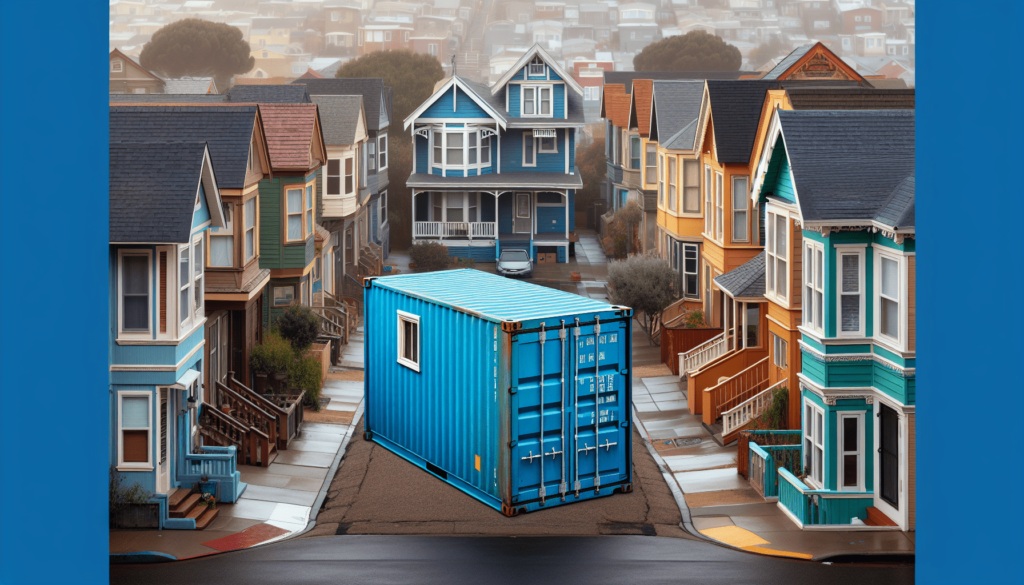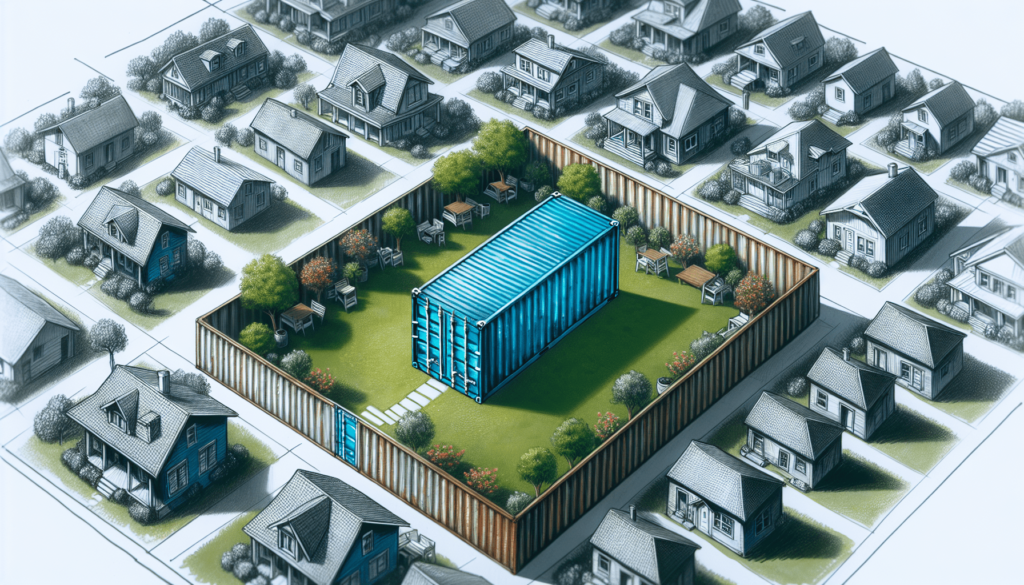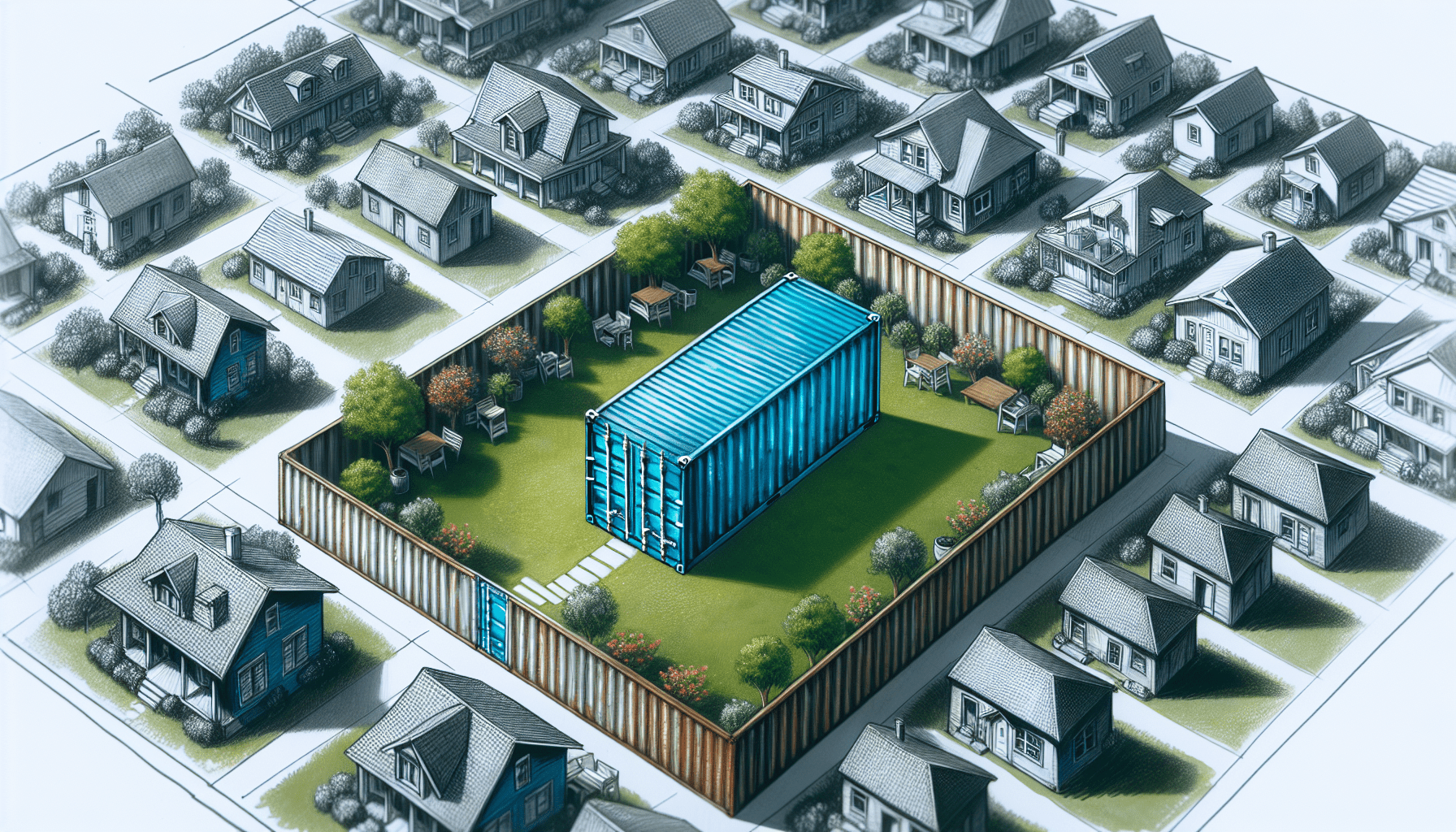Have you ever considered building a shipping container home? While the idea may initially seem appealing, it’s important to explore the potential drawbacks before embarking on such a project. From limited space and lack of structural integrity to potential health hazards, there are several reasons why building a shipping container home may not be the best option. In this article, we will discuss some compelling reasons why you should reconsider building a shipping container home and explore alternative housing solutions that may better suit your needs.
Structural Limitations
Limited load-bearing capacity
One significant limitation of shipping container homes is their limited load-bearing capacity. Shipping containers are not originally designed to support heavy loads, so any modifications or additions to the structure must be carefully planned and executed to ensure stability. Without proper reinforcement and structural support, the container may be unable to bear the weight of additional floors or substantial interior modifications.
Difficulty in modifying the structure
Modifying the structure of a shipping container home can be quite challenging. The rigid steel walls make it difficult to create openings for doors, windows, or other design elements. Cutting into the metal may weaken the container’s integrity, requiring reinforcements to maintain its structural stability. This limitation significantly restricts the ability to customize and personalize the interior and exterior of the container home.
Risk of corrosion and damage
Shipping containers are subjected to harsh conditions during their transportation across oceans, which can result in corrosion and damage. The exposure to saltwater and moisture can lead to rust formation, weakening the structural integrity of the container. Repairing and preventing further corrosion can be a time-consuming and costly process. Additionally, the original flooring of shipping containers is often treated with chemicals that may be harmful to human health if not properly addressed or replaced.
Lack of Insulation
Difficulty in maintaining proper temperature
One of the most significant challenges with shipping container homes is maintaining a comfortable and consistent indoor temperature. The steel walls of the container provide little to no insulation, making it difficult to prevent heat loss in colder climates or minimize heat gain in warmer regions. As a result, container homes can become unbearably cold or hot, requiring the use of additional heating or cooling systems, which can be energy-intensive and costly to operate.
Energy inefficiency
The lack of insulation in shipping containers also contributes to their energy inefficiency. Without proper insulation, the interior spaces lose heat or cold air rapidly, leading to a higher demand for heating or cooling systems. This increased energy consumption not only affects the environment but also results in higher utility bills for homeowners. Achieving energy efficiency in a shipping container home often requires retrofitting insulation materials, which adds to the overall cost and complexity of the project.
Condensation issues
Another drawback of the inadequate insulation in shipping container homes is the potential for condensation problems. Moisture can accumulate on the interior metal surface when warm air comes into contact with the cooler walls, leading to dampness and potential mold growth. Addressing condensation issues may require additional ventilation systems or moisture barriers, further adding to the complexity and cost of the construction process.

Zoning and Legal Restrictions
Local building codes may not allow container homes
Before embarking on a shipping container home project, it is crucial to thoroughly research and understand the local building codes and regulations. Many municipalities have zoning restrictions or building codes that prohibit the use of shipping containers as primary dwellings. These regulations often stem from concerns about structural integrity, fire safety, and neighborhood aesthetics. Failure to comply with these regulations could result in fines, legal complications, or even the demolition of the container home.
Permitting and licensing challenges
Obtaining the necessary permits and licenses for a shipping container home can be a complicated process. Different jurisdictions may have different requirements and procedures, adding to the complexity and time required to navigate the bureaucracy. Homeowners may need to invest considerable effort and resources in gathering the required documentation, submitting architectural plans, and meeting specific criteria to obtain the necessary approvals, further delaying the construction timeline.
Restrictions on placement and design
Even if container homes are allowed in a particular area, there may be restrictions on their placement and design. Homeowners may be limited in terms of their ability to place the container home in desired locations, such as residential neighborhoods or certain zoning districts. Additionally, there may be constraints on the size, height, or exterior appearance of the container home to ensure it aligns with the surrounding architecture and neighborhood harmony. These restrictions can limit the creative possibilities and adaptability of container homes.
Limited Space and Layout Constraints
Standard container dimensions restrict design possibilities
Shipping containers have fixed dimensions, typically measuring around 8 feet in width, 8.5 feet in height, and varying lengths of 20 or 40 feet. These standardized dimensions can pose challenges when it comes to designing a livable and functional space. The limited width may result in narrow rooms, while the low ceiling height can make the interior feel cramped and claustrophobic.
Difficulty in creating multi-level structures
The structural limitations of shipping containers also make it challenging to create multi-level structures. Due to their narrow width and limited load-bearing capacity, stacking containers to create additional floors may require extensive reinforcement and expensive engineering solutions. The need for additional support and the inclusion of staircases can further reduce the available interior space and limit design flexibility.
Limited interior space
Despite the increasing popularity of minimalistic living, the limited interior space of shipping container homes can still be a significant drawback for many individuals. The narrow width and fixed dimensions of the containers restrict the amount of usable floor area, making it difficult to accommodate large furniture or incorporate spacious living areas. The lack of space can lead to a cramped and cluttered living environment, especially for those accustomed to more expansive homes.

Difficulty in Plumbing and Electrical Installations
Limited access for necessary installations
The structural design of shipping containers poses challenges for plumbing and electrical installations. The pre-existing openings in the container may not align with the desired placement of plumbing fixtures or electrical outlets, requiring modifications and potentially compromising the structural integrity of the container. Additional cutting, welding, and reinforcement work may be needed to facilitate the proper installation of these essential systems.
Complexity in routing pipes and wiring
Routing pipes and wiring within the confined spaces of shipping containers can be a complex and time-consuming task. Limited access and space constraints can make it challenging to position plumbing lines, electrical conduits, and ventilation systems optimally. Careful planning and coordination with experienced professionals are crucial to ensure that all systems are properly installed and meet the necessary building codes and safety standards.
Additional costs for retrofitting
The need to retrofit plumbing and electrical systems in shipping container homes can significantly increase the overall construction costs. From hiring specialized contractors to purchasing the necessary materials, the expenses can quickly add up. Additionally, the complexity of the installations may require additional inspections and tests, resulting in further financial burdens. These additional costs should be carefully considered when evaluating the feasibility and affordability of a shipping container home.
Potential Health and Safety Issues
Presence of hazardous coatings
Shipping containers are often coated with toxic substances such as lead-based paints or asbestos-containing materials to protect them from corrosive elements during transport. These coatings can pose serious health risks if not properly addressed or removed. As homeowners unknowingly expose themselves to these hazardous materials during renovations or remodeling, they put themselves and their families at risk of long-term health complications.
Air quality concerns
The confined and airtight nature of shipping container homes can result in poor indoor air quality. Without adequate ventilation systems, pollutants and allergens may accumulate, leading to respiratory issues or other health problems. Proper air circulation and filtration systems are essential to maintain a healthy living environment in container homes. However, incorporating such systems can add to the complexity and cost of the construction process.
Lack of fire safety features
Fire safety is a critical concern in any home, and shipping container homes often lack the necessary fire safety features. The use of highly combustible materials and the limited escape routes can increase the risk of fire hazards. Additionally, the absence of fire-resistant barriers and insulation in the original container structure may facilitate the rapid spread of flames. Extra precautions should be taken to ensure the safety of occupants, such as installing fire-resistant materials and implementing robust fire detection and suppression systems.
Financial Considerations
High upfront costs for purchasing and transporting containers
Although shipping containers may seem like an affordable building material, the initial costs of purchasing and transporting the containers can be substantial. While used containers may be less expensive than new ones, they still require thorough inspection and potential repairs. Furthermore, shipping containers must be transported to the construction site, which can involve specialized equipment and incur additional fees and logistical challenges.
Additional expenses for insulation and customization
The lack of insulation in shipping containers necessitates additional expenses for insulation materials, weatherproofing, and moisture control. Retrofitting the containers to meet energy efficiency standards and create a comfortable living environment requires careful consideration of costs. Additionally, customization and interior design elements, such as flooring, wall partitions, and plumbing fixtures, can further drive up the overall expenses.
Limited resale value
While the demand for shipping container homes is growing, they may not have the same resale value as traditional houses. The unconventional nature and potential limitations of container homes may deter some buyers, reducing their market appeal. Additionally, the relatively short lifespan of shipping containers compared to traditional building materials can impact their long-term value. Potential homeowners should consider the long-term financial implications and potential resale challenges before investing in a shipping container home.
Aesthetics and Neighborhood Harmony
Container homes may not blend well with surrounding architecture
Shipping container homes often have a unique and distinct appearance that may not blend well with the surrounding architecture of traditional neighborhoods. The industrial and utilitarian aesthetics of the containers can stand out and appear out of place, potentially impacting the visual harmony of the community. Consideration should be given to the neighborhood’s architectural style and character to ensure that the container home complements rather than disrupts the overall aesthetics.
Possible negative impact on property value
The unconventional nature of shipping container homes can sometimes lead to concerns about their impact on property values. Some potential buyers or neighbors may perceive container homes as lower quality or less desirable compared to traditional houses. This perception can affect the perceived value of neighboring properties and potentially decrease their market worth. Consultation with local real estate experts or appraisers can provide valuable insights into the potential impact on property values.
Resistance from the local community
The idea of living in a shipping container home may not be well-accepted by the local community or homeowners associations in certain areas. Concerns about perceived lower property values, potential changes in neighborhood aesthetics, or unfamiliarity with container homes can lead to resistance or objections from neighbors or local authorities. It is essential to engage in open and constructive communication with the community to address and mitigate their concerns proactively.
Limited Availability and Accessibility
Containers may not be readily available in desired locations
The availability of shipping containers can vary depending on the geographical location and demand. In some areas, sourcing containers in good condition can be a challenging and time-consuming task. The need to search for suitable containers and potentially transport them from distant locations can add logistical complexities and costs to the project. It is important to assess the availability of containers before committing to a shipping container home construction.
Transportation costs for remote areas
Shipping containers are typically designed for transport via heavy-duty trucks, trains, or cargo ships. If the construction site is in a remote or inaccessible location, the transportation costs for delivering the containers can become prohibitively expensive. The logistical challenges and costs associated with transporting containers over long distances or challenging terrains should be carefully evaluated to determine the feasibility of a shipping container home in a specific location.
Difficulty in finding suitable containers
Not all shipping containers are created equal, and finding suitable containers for construction purposes can be a daunting task. Containers must be thoroughly inspected to ensure they are structurally sound, rust-free, and free from hazardous coatings. With the increasing popularity of container homes, the availability of acceptable containers may be limited, making it more challenging to find suitable units that meet the required criteria.
Sustainability Concerns
Environmental impact of repurposing containers
While repurposing shipping containers for homes is often touted as an eco-friendly approach, it is important to consider the environmental impact holistically. The manufacturing and transportation of the containers themselves require significant energy and resources. When repurposing containers, extensive modifications, insulations, and reinforcements may be needed, resulting in additional materials and waste. The overall sustainability of a shipping container home depends on careful consideration of these factors throughout the construction process.
Energy-intensive manufacturing process
The manufacturing process of shipping containers involves high energy consumption, primarily due to the use of steel and heavy machinery. The extraction of raw materials, the melting and shaping of steel, and the transportation of the containers all contribute to a significant carbon footprint. When evaluating the sustainability of a shipping container home, it is important to consider the environmental impact associated with the containers’ manufacturing process.
Short lifespan of containers
Shipping containers are designed to withstand the harsh conditions of international shipping for a limited period. After being retired from their original purpose, they often have a shorter remaining lifespan compared to traditional building materials. Over time, the containers may deteriorate due to rust, corrosion, or structural weaknesses. This shorter lifespan can impact the long-term sustainability and durability of a shipping container home, potentially requiring costly repairs or replacement in the future.
In conclusion, while the idea of building a shipping container home may seem appealing, it is important to consider the numerous limitations and challenges associated with this unconventional approach. From structural constraints to zoning restrictions, and from insulation issues to potential health and safety hazards, there are various factors that need to be carefully considered before embarking on a shipping container home project. With thorough research, planning, and consultation with experienced professionals, it is possible to overcome these challenges and create a comfortable and sustainable living space. However, it is crucial to assess whether the benefits and unique aspects of shipping container homes outweigh the potential drawbacks and limitations in your specific circumstances.

I am James, the creator behind SeaBoxInnovations.com. Welcome to our premier online destination dedicated to the world of sea containers. Think Inside the Box is our tagline, and our website is your go-to source for exploring the endless potential of these versatile and adaptable containers. Whether you’re interested in purchasing, customizing, or learning about the latest trends in container architecture and design, we have you covered. Join us as we bridge the gap between traditional uses and cutting-edge applications, promoting sustainability and innovation in design and construction. Get ready to embark on your next big project with SeaBoxInnovations.com.

